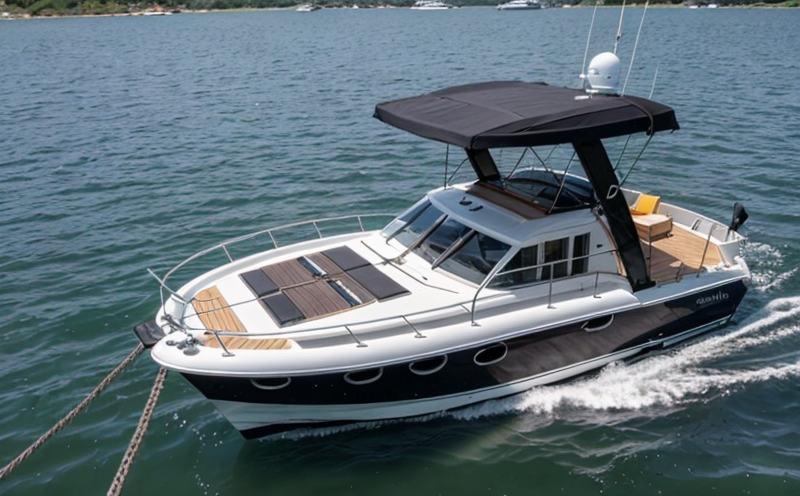ISO 2415 Shackle Strength Testing for Mooring & Anchoring
The ISO 2415 standard is a critical benchmark in marine and ship equipment testing, particularly when assessing the strength of shackles used in mooring systems. Shackles are essential components that connect various parts of a ship’s rigging, ensuring safety during operations such as anchoring and mooring.
The test procedure outlined in ISO 2415 is designed to evaluate the tensile strength of shackle specimens under controlled conditions. This ensures that shackle manufacturers adhere to strict quality control standards, thereby enhancing maritime safety. The testing process involves subjecting a shackle sample to a defined load until failure occurs. This method allows for accurate determination of the ultimate tensile strength (UTS) and proof strength.
The shackles used in mooring systems are subjected to high loads that can vary depending on the vessel size, environmental conditions, and specific application requirements. For instance, a shackle used in the mooring lines of an oil tanker will experience significantly higher stress compared to one used in recreational vessels. Understanding these load characteristics is crucial for ensuring that the shackles meet international standards like ISO 2415.
The testing process typically involves several key steps:
- Selection and preparation of shackle specimens
- Calibration of test equipment to ensure accurate load application
- Application of a defined load incrementally until the specimen reaches its breaking point
- Data collection and analysis to determine UTS and proof strength
The importance of this testing cannot be overstated. In marine environments, where equipment must perform reliably under extreme conditions, any failure can lead to catastrophic consequences. The ISO 2415 standard ensures that shackle manufacturers produce products capable of withstanding the stresses they are designed for.
Compliance with ISO 2415 is mandatory in many maritime jurisdictions and is a key factor in obtaining certifications such as American Bureau of Shipping (ABS), Lloyd’s Register, Det Norske Veritas (DNV), and others. Compliance also helps shackle manufacturers meet the stringent requirements set by shipyards and operators.
The standard covers various types of shackles used in mooring systems, including single-bow, double-bow, and multi-loop shackles. The testing procedure is designed to reflect real-world loading conditions, making it an indispensable tool for ensuring maritime safety.
Benefits
The benefits of ISO 2415 shackle strength testing are numerous and far-reaching. Firstly, it ensures that all shackle products meet the highest international standards, thereby enhancing maritime safety. Secondly, compliance with this standard can lead to reduced insurance premiums for ship operators who use certified shackles.
Additionally, ISO 2415 testing provides a level playing field for manufacturers by ensuring that all products undergo the same rigorous testing process. This not only promotes fair competition but also ensures that buyers have confidence in the quality of the products they purchase.
The data generated from these tests is invaluable for R&D engineers and quality managers, as it allows them to identify areas for improvement and optimize product design. For procurement officers, this testing ensures that the right quality materials are being sourced, thereby reducing the risk of substandard products reaching the market.
International Acceptance and Recognition
The ISO 2415 standard is widely recognized and accepted across the maritime industry. This recognition is due to its rigorous testing protocol, which ensures that shackle products meet stringent quality standards.
Many leading shipyards and operators specify compliance with this standard as a condition for accepting shackles into their inventory. For example, ABS, Lloyd’s Register, DNV, and other major classification societies require suppliers to provide ISO 2415 test reports when tendering for contracts.
The acceptance of this standard also extends to regulatory bodies in various countries. In jurisdictions like the United States, the Federal Maritime Commission (FMC) and the International Organization for Standardization (ISO) both recognize the importance of ISO 2415. This recognition ensures that shackle products meet international standards, facilitating trade across borders.
The widespread acceptance of this standard is a testament to its effectiveness in ensuring maritime safety. Compliance with ISO 2415 helps manufacturers and suppliers gain a competitive edge by demonstrating their commitment to quality and safety.
Competitive Advantage and Market Impact
- Enhanced Reputation: Compliance with ISO 2415 enhances the reputation of manufacturers and suppliers, making them more attractive to buyers in competitive markets.
- Increased Demand: The standard’s stringent requirements can lead to increased demand for products that meet these standards, thereby boosting sales and market share.
- Better Pricing Power: With higher quality standards come the benefits of better pricing power. Suppliers who comply with ISO 2415 are often able to command premium prices due to their reputation for reliability and safety.
- Reduced Risk: By ensuring that products meet international standards, manufacturers can reduce the risk of product recalls and legal disputes.
The acceptance of this standard by major maritime organizations and regulatory bodies has a significant impact on the market. It creates a robust framework for quality control and ensures that all players in the industry are held to the same high standards. This, in turn, fosters trust among buyers and stakeholders, leading to increased business opportunities.
The standard’s rigorous testing protocol also sets a benchmark for innovation within the industry. Manufacturers who adhere to ISO 2415 are more likely to invest in research and development, leading to continuous improvement in product quality and safety.





